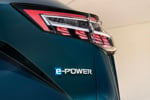You don’t need to know your route, just let the box of tricks take care of it.
And it works perfectly – until you get stuck in traffic for two hours. If only the sat-nav could have known about the accident up ahead, or the gridlock caused by roadworks.
Chances are that if you’ve driven a vehicle with built-in sat-nav recently, you’ll know that such magic is a reality.
Increasingly, cars with an in-built system are being fitted with a feature known as the Traffic Message Channel, or TMC, which aims to alert you to traffic congestion, roadworks and accidents that could hamper your journey. It flags up problems with an icon on the map display and will attempt to re-route your journey if you want it to.
Although TMC, or RDS-TMC to give it its full title, has only become widely-used in recent years, the technology is far from new.
The concept of alerting motorists to traffic problems first appeared two decades ago, when technology giants Bosch and Philips realised its potential. Their research led to Europe-wide programmes which in turn led to EU-funded implementation trials.
In the past eight years, TMC has been rolled out worldwide, thanks to global standards on how it operates. Such standards are overseen by the Brussels-based TMC Forum, which ensures the system is universal – a UK car driving through France can receive traffic information in English from the French system operators with no additional equipment needed.
In the UK, there are two major rivals running TMC systems, Cheshire-based ITIS Holdings (since 2001) and satellite navigation specialist Trafficmaster (since 2005).
Trafficmaster uses a network of 7,500 blue cameras mounted at the side of motorways and trunk roads feeding real-time information to a control centre in Milton Keynes. It also uses the London Congestion Charge cameras to build up a more detailed picture of congestion in the capital.
Like ITIS, Trafficmaster has a fleet of vehicles for the gathering of additional information. As well as customers of its SmartNav sat-nav system, it also has a partnership with Norwich Union, using information from customers with black-boxes for insurance purposes. Together, those vehicles number more than 100,000.
Andrew Smith, ITIS’s automotive business director, says the firm’s network of vehicles numbers more than 100,000 and has the majority of the UK TMC market.
‘In the UK, we get our data in two types,’ he explains ‘The first is all about road speed information, the flow on the network, how fast traffic is moving.
‘We get that from vehicles roaming the road networks. They are primarily fleet vehicles from various fleet management and telematics companies.’
The fleet vehicles roam the UK and provide ITIS with real-time information on speed and position. Processing the data received builds a clear picture of the road network.
‘The second type is journalistic data from traditional sources of information,’ Smith continues. ‘Traffic information collected and transmitted to radio and television stations is also sent to us.’
TrafficLink, the source of that information, provides traffic updates to 90% of the UK media. The firm has regional offices and talks to traffic control, local authorities, police and the Highways Agency to get updates, as well as monitoring traffic sensors across the road network.
The information is merged with the data gathered from the roaming fleet vehicles.
‘It’s no good seeing the speed on the M25 is 20mph if you don’t know the cause,’ Mr Smith says. The combined information is coded into the industry standard format and then broadcast.
ITIS has a licence from the communications regulator OFCOM which lets the firm broadcast Radio Data System (RDS) messages piggybacking on the back of Classic FM’s frequency. It also sends out its information through three local and regional stations.
‘In-vehicle navigation systems have FM receivers which decode and display the information on the screens,’ Mr Smith says. ‘RDS is the same technology that tells you what station you’re listening to.’
Trafficmaster uses a patchwork of local commercial radio stations – rather than one national one – to broadcast its signal.
Motorists using TMC may sometimes notice that traffic is not moving around them yet nothing is displayed on the screen. Similarly, their sat-nav might scream warnings of a jam while they happily sail along at 70mph.
‘No traffic information, no matter how it’s gathered, is going to 100% perfect,’ Mr Smith admits. ‘But we have an ongoing improvement pro-gramme. ‘If you’re in a jam and you haven’t received information about it, it could be down to a number of things.
‘Sometimes you’ll be in an area that won’t receive the information. We try to do what we can to capture the information and we work very closely with the terminal manufacturers to ensure their systems are performing as well as possible with our data.
‘We feel confident that what we’re delivering is of the best quality possible.’
At the moment, TMC is only available on sat-nav systems fitted into the vehicle, but that’s likely to change in the near future.
‘The industry is working on new technology in terms not only of traffic content but also ways of getting into the mobile environment, in a vehicle or on a handheld device,’ Mr Smith says.
‘TMC has so much cross-industry support it’s not going to change overnight,’ Mr Smith says, ‘but it continues to improve and once you have had navigation with dynamic information like traffic data, you never go back.
‘To be able to see traffic problems means you can take an informed decision on your route. For business use it’s critical and a massive godsend.’















Login to comment
Comments
No comments have been made yet.